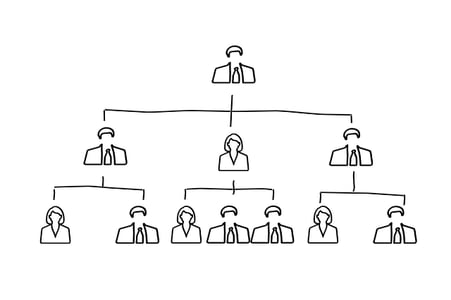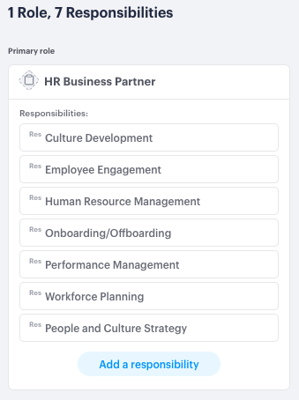Every business needs the proper resources to be successful. What falls under the umbrella of “resources” can vary widely.
There are physical resources — the equipment, property, and technologies a business needs. Financial resources refer to funding. All of these things can be purchased, leased, or obtained from lenders and investors.
Human resources are different. These must be recruited, trained, and retained. They can’t simply be purchased. Additionally, without human resources, none of the other resources are used in a way that creates growth or success.
 Humans: a different kind of resource!
Humans: a different kind of resource!
The HR team is solely responsible for ensuring that a business has these most important resources. Because of that, it’s easy to argue that the HR team is absolutely key to the success of any organization and that it should be carefully structured for the best results.
How do you design your HR team structure? Below, we will discuss options for businesses of different sizes, how you should structure your HR department, and the overall importance of HR to the rest of the organization. Then, we’ll cover the importance of using HR organizational charts as part of the structuring process.
The Importance of the HR Team
When you structure your HR team, it’s crucial that you consider its importance to your organization, how it relates to your other teams, and the functions it performs. Integration between teams is a major determiner of success. It’s vital that your company has a clear understanding of these relationships.
It helps to begin with the seven major functions of an HR team. These are:
- Establish company culture
- Hire and recruit staff
- Manage relations between workers and management
- Offer and manage training and development
- Manage payroll and benefits
- Oversee disciplinary actions and policy compliance
- Maintain a safe work environment
These are very high-level functions, of course. In order to deliver on them successfully, members of the HR team and its leaders must cover a multitude of sub-tasks and responsibilities.
HR Operating Models
Your HR operating model is the way your human resources department is structured to deliver those services and add value to your organization. When you choose an operating model, take into account how both internal and external stakeholders will benefit as well as how your HR team can live up to its value proposition.
There are five types of HR operating models. They are:
1. Functional
The functional model is most commonly adopted by smaller businesses. In this model, the HR team is split into areas of expertise and function. These departments report to an HR leader. In a functional model, decisions come mostly from the top down.
2. Hub and Spoke
The center or hub of this model contains the core functions of the HR team. These are strategy, technology, solutions design, and shared services. The spokes represent the delivery of services relating to those functions and any advisory activities that happen to that end.
3. Business Partner
This is the most common HR model. In a business partner model, the HR team functions as a business partner to other business areas and the organization as a whole.
The goal is that HR participates in the development and execution of strategies that help the organization achieve its objectives via the services it offers. In this model, there are reporting lines that extend from the HR business area to others and also to a centralized leadership within the team.
A simplified structure showing the typical dotted reporting line relationships in a HR Business Partner operating model.
4. Front-Back Delivery
Here, HR operates as a back-office function that is available to all business areas. These functions include technology, solutions, and delivery of HR services. However, there can be an individual HR strategy that exists for each functional business area.
This model also allows for specific technologies to be implemented for other departments in addition to centralized technologies.
5. Federated
When a business is federated it is split into multiple independently functioning divisions. These are often created geographically. However, business areas may also serve as their own federations.
The federated model of HR operation was designed to structure the HR team and the delivery of its services to meet the specific needs and goals of each federation. For example, an HR team with different roles and responsibilities might report to a federated division of a company.
The HR operating model you choose will be influenced by the size of your company, your business goals, and how you have structured your organization as a whole.
The choice you make will determine how your HR team integrates with the rest of your organization. It will also delineate the reporting lines that run through your HR business area internally and to other teams.
HR Team Structure
No matter what operating model you choose, you have to create a functioning HR team. The way you structure the team will impact the delivery of services and whether you have the resources and competencies available to execute the seven major functions of human resources.
It’s important to follow some best practices when defining the internal organizational structure of your HR team.
Business size has a major influence on team structure. Let’s start with a small business. Often, a small business HR team may consist of only two or three people. These team members often take on responsibility for multiple functions.
As far as hierarchy, HR team members in a small business often report directly to someone in executive leadership, such as an HR department head. They may also report directly to the CEO or owner.
A medium-sized organization is more likely to have a larger HR team. Individuals on the HR team may be hired to perform a specific function rather than being in charge of multiple functions. Additionally, there may be multiple people working on an HR team that is in charge of a specific function or group of related functions.

This may lead to additional hierarchical layers. For example, two recruiters and a training specialist may report to a team leader who is responsible for staffing and development. That person may then report to the person in charge of HR.
A larger organization is likely to have a larger HR team with deeper hierarchical levels. Enterprise-level HR teams are also more likely to adopt HR operating models that are decentralized or assign HR team members and functions to specific business areas. This can complicate reporting lines as well as resource assignments.
An HR Organizational Chart
An HR org chart is a visual representation of your HR team that is influenced by your HR operating model and internal team structure. It can function as a standalone chart or as part of a larger org chart. In the latter, the connections and reporting lines run between your HR team and other business areas.
Thanks to modern software used to design HR org charts, these have become dynamic documents that include the following features:
- Exporting job description information
- Integrating with Slack to pull user information and images
- Reporting functions
This is in addition to these org charts mapping out roles, responsibilities, reporting hierarchies, and relationships.
 An example of responsibility and role assignment in Functionly.
An example of responsibility and role assignment in Functionly.
A business in any state of development can benefit from creating an HR organizational chart and adding it to its company documentation.
For example, a startup or very small company that doesn’t yet have an existing HR team can use org chart software to plan and develop its initial HR team. This would include assigning roles and responsibilities to ensure that the team can effectively deliver services to other business areas and serve external stakeholders (such as job applicants).
A company that is experiencing difficulty with one or more of the seven major HR functions can use an org chart for auditing purposes. Leaders will be able to identify gaps and redundancies that could explain where there aren’t enough resources or where inefficiencies exist.
HR organization charts are also valuable for future planning when organizations are undergoing significant changes. This might include expansions, restructuring, or mergers and acquisitions.
With an HR org chart tool, company leaders can review a variety of scenarios that are related to the internal structure of the human resources team and its relationship to the rest of the business.
Functionly offers intuitive, drag-and-drop org chart software that allows businesses to map out the structure of their human resources department as well as other business areas.
This tool also includes a range of functionalities that empower users to collaborate with one another, align responsibilities, map accountabilities, and engage in vacancy planning. These along with other resources have an important place in any growth-focused organization.
Learn more about other different team structures.





